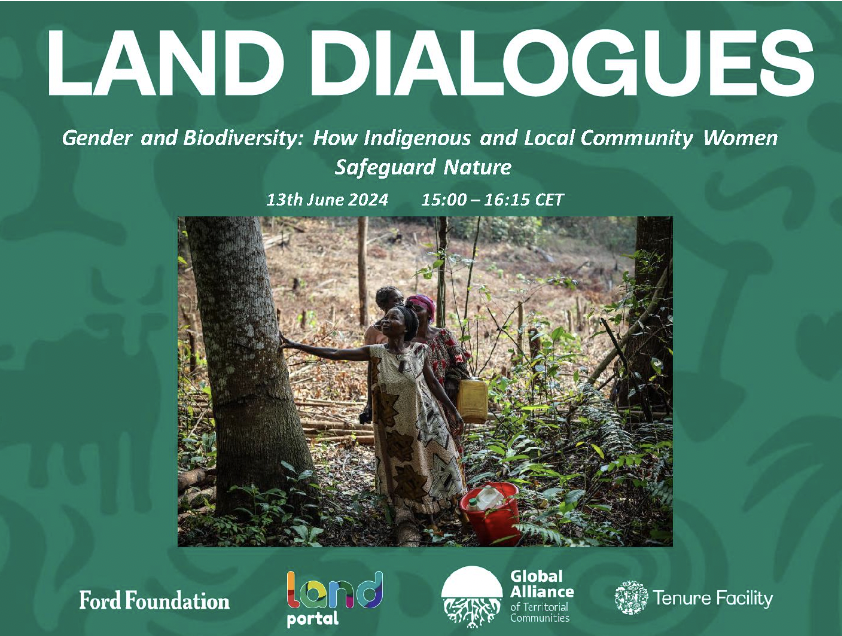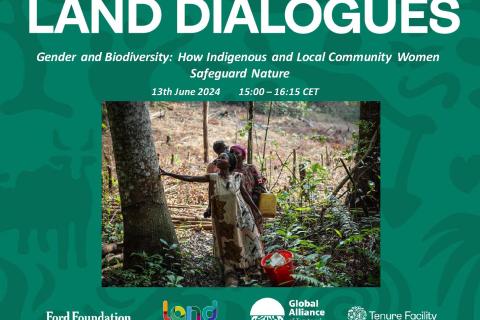Under the umbrella of the Land Dialogues series, the first webinar of this year’s series “Gender and Biodiversity : How Indigenous and Local Community Women Safeguard Nature” took place on June 13th, 2024. The webinar drew in a little over 300 participants and featured Indigenous and local community leaders from around the world. The series is organized by a consortium of organizations, including the Land Portal Foundation, the Ford Foundation and the Tenure Facility and this particular webinar was organized in collaboration with the GATC.
Thin Lei-Win, freelance journalist specializing in food and climate issues moderated the panel, which featured the following speakers:
- Aissatou Oumarou, REPALEAC Vice-Coordinator
- Cristiane Pankararu, ANMIGA Co-Founder
- Gloria Samana, Elder from the Embera People of Panama
- Josselyn Casama, Young leader from the Embera People of Panama
Please see a brief recap of the full captivating conversation.
1) We’ve heard about the important role that Indigenous women play in biodiversity preservation and climate mitigation, from researchers, civil society, and indigenous women themselves. But could you perhaps explain to us how this works in your community? How do women in your communities contribute to biodiversity preservation and climate mitigation?
Aissatou: Women all over the planet are the ones who take care of communities and families. Through these women, there is preservation of biological diversity but also of the environment more broadly. The woman is the one who takes care of her family and community, and is the one who seeks out leaves to cook, educates children. She is also the one who takes care of the health of the children. In terms of health, she is the one who has to go into the bush to look for the leaves and branches, the roots that are going to help her treat her children. That is part of biodiversity, but it is also part of this very rich traditional knowledge for women. When she takes these trips, she takes her children with her and shows them which leaves can help them cure ailments, diseases, which are for eating or which are toxic, for example. She can make them aware of the characteristics of different plants. In the same way, when she sees a tree that is sick, she is going to try to help this tree. If she takes the bark of the tree, for example, she is going to prepare mud to apply to the tree so that the tree can heal from the wound that she has inflicted on it. This protects the tree, and in turn protects families and the community.
Josselyn and Gloria: One of the ways that we preserve the forests is through the preservation of our culture, our mother tongue as well as trying to preserve our traditional medicine. Women try to use the knowledge that we gain from our grandparents when it comes to planting and harvesting, by using no chemicals whatsoever. Through this, we are restoring the forests with nature. Women also keep the balance that the family needs and protects the family and communities as a whole.
2) How do Indigenous women pass traditional knowledge from one generation to another. How do they do this? What are some of the challenges you face in doing this?
Aissatou: Transmission is necessary - when you are a woman and a mother, you need to show your children and your daughters especially, how you are doing all of the activities mentioned above. Every step you are taking is a type of school and a teaching process and the next generation is following what you are doing. When we go to the forest to pick leaves, bark or roots, most of the time we will bring our children and show them the best process and method for this. We will really show them how to remove the necessary part of the leaf or plant, and allow the plant to regenerate itself in the best way possible. We also teach about warning signals for weather forecasting for example, which is useful for our children to know and it is important for them to assimilate this information from a very young age.
Josselyn and Gloria: In my community, we teach women of the next generation how to transmit traditional knowledge. We explain more about traditional medicine, our cultural traditions, the dances and dress from our community as well as cultural practices like painting. We do this primarily through teaching our children and remind them that our culture is not to be forgotten and lost. We explain what each leaf and plant is used for, so that they may understand more about traditional medicine.
3) COP16 is coming up. In an ideal world, what would you like to see happen there and also for the Global Biodiversity Framework?
Cristiane: We want to be able to discuss topics such as loss and damage, environmental loss, direct financing to the communities, sovereignty, food safety and security, carbon credits and much more. We are now strengthening ourselves in self-organized spaces to discuss these topics, since we have gone through a six year administration with the Bolosonaro regime when Indigenous Peoples participation in councils and commissions was completely eliminated. We were not able to make progress and we are catching up now. We are trying now to bring discussions around the biodiversity convention to the forefront, and in a more accessible manner to our public and communities. We are working on diluting technical themes and jargon so that our people, in their own languages and ways of being, can comprehend them and use them as mechanisms to safeguard their sacred knowledge, since traditional knowledge has a lot to do with what is sacred to us. We are also affected by misogynistic and patriarchal structures and we are preparing to confront those structures and take a stand at COP16.


